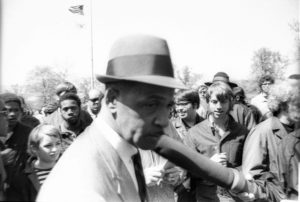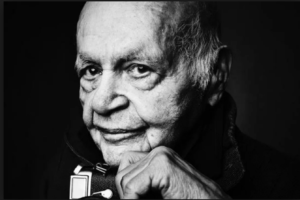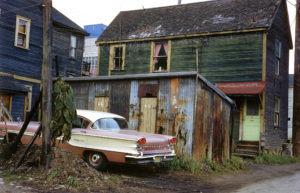Text and photograph by Bruce Berman
Good ole days… when every inch wasn’t being developed.
It’s a time of emptiness and greed and of “not enough of too much.”
Period.
Text and photograph by Bruce Berman
Good ole days… when every inch wasn’t being developed.
It’s a time of emptiness and greed and of “not enough of too much.”
Period.
July 1942. “Chevy Chase, Maryland. Serving supper to motorists at an A&W Hot Shoppes restaurant
on Wisconsin Avenue, just over the District line,” by Marjory Collins for the Office of War Information
Read More: https://www.loc.gov/rr/print/coll/womphotoj/collinsessay.html
School Girls on a bus in Juárez, 2002
How many times have I wanted to cross over the Bridge to Juárez, jump on a ruta autobus and never return to mi lado (the other side, El Paso, America) again?
A bunch of times. Actually, in the last decade, every time. ¡Muchos tiempos!
When I go to Juárez I realize within minutes that the bubble I live in America is a prison not a home. It’s a construction. A development.
Instead of working this feeling out, I take photographs, like an archeologist, always trying to root out what this means, and, for a very long time that has been enough.

Old Civil Rights leader lost in the crowd, (from ChiTown Journal) Chicago, by Bruce Berman. 1968
TEXT AND PHOTOGRAPH BY BRUCE BERMAN
Eras are always changing. They’re changing now. Old liberals aren’t enough now, socialists may not be enough next year.
In 1968 the era was changing as well. In the photograph above, Martin Luther King had been assassinated only six months before. Bobbie Kennedy, only three months before.
The old Civil Rights movement was being paralleled by the anti-war movement. The old Baptist church arguments, high on morality and sincere ecumenicalism of previous years was being replaced by the Hell No I Won’t Go movement, sincere, but clearly lacking in thought-out ideology. “I won’t go,” isn’t a spiritually-driven theology.
In one of the many protests in the hot summer of 1968, in Chicago, during the Summer of Rage, Part II, the contrasts between these two eras was becoming evident and the clash was real. The old Civil Rights leaders’ voices were being drowned out by the new Black Nationalist voices of the Black Panthers and others. The middle class kids were more enraged by getting grabbed by the Draft Boards than they were by Segregationist southern sheriffs.
This photograph, shot in Lincoln Park, Chicago, in August 1968 was a glimpse into the divide to come. By September, 1969, fourteen months later, the divide was complete. MLK was gone. The Kennedys were gone, Black Panther Fred Hampton had been assassinated by the Red Squad of the Chicago PD, Bill Ayers and the SDS Weathermen started to learn the craft of bomb-building (and went underground one year later), and the old, moral voice of the Civil Rights movement was all but drowned out in the dark and strident days that tagged the next ten years in the coming 1970s.
Eras change.
Nelson Algren at his Chicago home site as it is being
wrecked for a new expressway, by Art Shay. 1957
INTRODUCTION BY BRUCE BERMAN
Here is a great interview by Mike Thomas, for Chicago Magazine, with Art Shay, the great Chicago photographer of the 1950s, 60, 70s, 80s, 90s and, yes, even the 2000s. He was relentless, gritty, no nonsense, a true artist (because he didn’t consider himself to be one). I used to “soup” his film deep in the bowels of Astra Photo Lab, at 6 E. Lake Street, in 1969. I didn’t know he was even an influence until 40 years later. His main lesson, by example, was: “…keep shooting, always keep shooting.”
 Mr. Shay passed on April 28, 2018. There will never be another Art Shay. He was one of a kind, in the manner of Weegee.
Mr. Shay passed on April 28, 2018. There will never be another Art Shay. He was one of a kind, in the manner of Weegee.
READ HERE: https://www.chicagomag.com/Chicago-Magazine/April-2018/Legendary-Photographer-Art-Shay-Tells-His-Remarkable-Story/
Art Shay by Art Shat
 Kid in an Abandoned Ford, Uptown (from ChiTown Journal),
Kid in an Abandoned Ford, Uptown (from ChiTown Journal),
Chicago, by Bruce Berman. 1971
Text and Photograph by Bruce Berman
Working on my book Chitown Journal.
Digging ahead on this but it’s like a time tunnel to yesteryear. The deeper I dig the darker it gets. Not sure, even, why I’m doing this except that I like looking at the images. When you’re looking back a couple of generations you wonder how these people turned out. What happened? Any millionaires, murderers, poets, policemen, shrinks, grave diggers, photographers, Aldermen?
Can’t know. All that I have is images. They tell many things but never facts and never data.
Roy DeCarava was one of the most influential documentary photographers of the 1950s-1960s. He was known more for the simplicity and ordinariness of his work than for it being spectacular or showy. His particular importance was photographing the Black community of his native Harlem and for the jazz scene of the era.
For a more thorough descrtiption of DeCarava’s work check out the always insightful Claire O’Neil’s essay at: https://www.npr.org/sections/pictureshow/2009/10/decarava.html

1941 publicity photo for Gypsy Rose Lee’s
first novel, The G-String Murders.